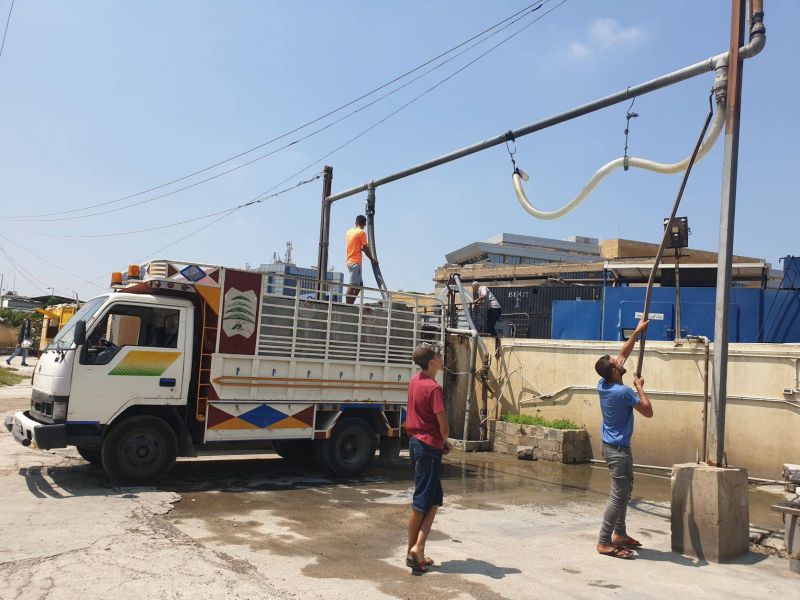
An informal water tanker in Lebanon. (Courtesy of Yasmina Choueiri)
Once again, residents of several Lebanese regions had to face a total interruption of water supply last week, due to "electricity shortages, major malfunctions and cable thefts," according to a statement from the Beirut and Mount Lebanon Water Establishment. Already widespread for years, especially during the summer, the shortages have worsened considerably with the economic and financial crisis that has shaken the country for more than two years, including the depreciation of the Lebanese pound and the dramatic situation of the electricity sector.
As early as July 2021, Unicef sounded the alarm by announcing that 71 percent of the Lebanese population could suffer from a lack of access to water, knowing that Lebanon is considered to be rather well endowed with water resources. Without sufficient financial capacity to ensure the regular operation of generators that are supposed to support power-pumping stations during power cuts, the country's four autonomous water establishments are struggling to carry out their mission.
As a result, in a country where nearly two-thirds of the population lives below the poverty line, households are increasingly forced to rely on informal systems — from deliveries of water tanks, bottled water, or water pumped from private domestic wells — and therefore, supporting the heavy burden of structural failures in the management of the sector.
High costs and disparities
Although the first water tankers appeared in the 1970s, and the informal market has not stopped growing since then, there was a sudden surge in the number of water tankers, especially after the dry years of 2013 and 2015. The drought events of those years augmented the disruptions of the formal system and significantly increased demand on the informal one. This led to an increase in the number of water tanker suppliers and an increase in competition among them. Ultimately this resulted in some players controlling accessibility to the water sources and the subsequent informal water market. This effect was double-sided. While in the short term, the increased number of water tankers decreased prices to end-users; this increase was automatically accompanied by over-pumping of groundwater in an unmonitored and uncontrolled way, which exacerbated seawater intrusion in Beirut and over the Lebanese coast.
While the cost of water tankers has slightly decreased, the cost of total water sources in Lebanon remains pretty high. In Beirut, the subscription fee for households was around $200 before the crisis (LL300,000 at the time) per year, for a “promised” fixed volume of one cubic meter per day. However, because of water shortages, households are also obliged to pay for additional informal sources (tankers, bottled water and wells), which summed up to an average of $1,900 per year at the time.
Generally, to ensure that water costs are fair and affordable, engineers and planners typically compare water costs with peoples’ incomes. There is a general consensus that the water affordability threshold of cost-to-income ratio ranges between two to five percent depending on location and context. This means that as long as you are paying less than five percent of your income to water, then you are accessing a rather affordable resource. In Beirut, the average cost-to-income ratio of total water sources (formal and informal) was around six percent before the crisis, according to a survey of 105 households of different socioeconomic levels. However, this figure hides strong disparities between lower and higher-income communities. For example, the average cost-to-income ratio of water for a lower-income community was around 10 percent, whereas for a higher-income community it was around four percent. This difference is mainly related to the purchasing power of higher-income communities.
Reinstate equitability and sustainability
To cope with shortages and incremental cost burdens, different communities apply different strategies. Lower-income communities compromised the quality of their drinking water by buying cheaper brand-less bottled water of uncertain quality. Moreover, they modify their consumption patterns by scheduling high consuming water activities (i.e. washing clothes) to the times when the municipal water is supplied (because it is the cheapest source). On the other hand, higher-income communities resort to expensive reverse osmosis units (water treatment units installed at building levels) that allow them to pump and treat unlimited amounts of water from their private wells compromising groundwater quality and sustainability.
By definition, informal systems are unmonitored and uncontrolled, so they can lead to social injustices along with environmental havoc by compromising water resources’ sustainability. To reinstate equitability and sustainability of water supply it is essential to bring back the effectiveness and reliability of the formal system in satisfying the water needs of communities enough to reach an acceptable level of trust. This is easier said than done, as all aspects of the current water system have to be assessed, including hydraulic, environmental, economic, societal, legal and political dimensions in order to develop long-range policies and viable solutions.
Informal water systems have a catch, while they help communities resolve their water accessibility stresses, they come at additional costs, augmenting disparities among communities and depleting resources. Unfortunately, as long as the formal system is failing, the informal one cannot be eradicated. A holistic range of strategies, that take multiple dimensions, is needed to gradually reinstate formal systems' effectiveness.
When the trust of communities is regained, only then informal systems can be abandoned.
Dr. Yasmina CHOUEIRI has just completed her Ph.D. from the University of California Davis. She is currently a Visiting Assistant Professor at Université Catholique de Louvain (Belgium) and an Urban Environmental Consultant.